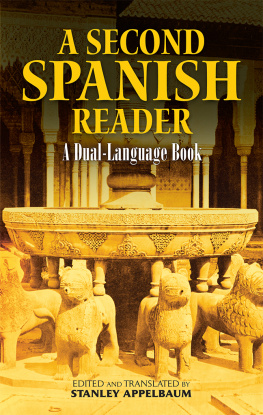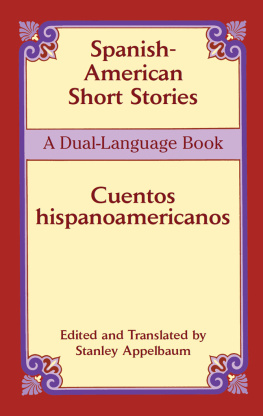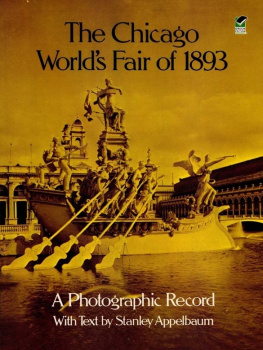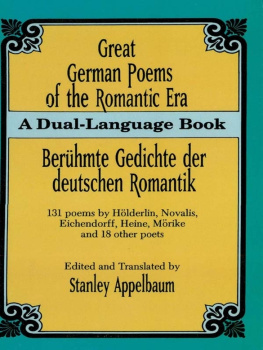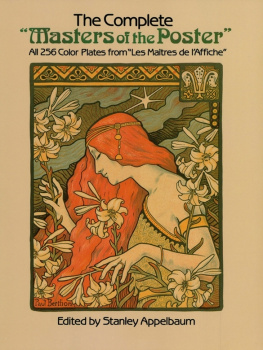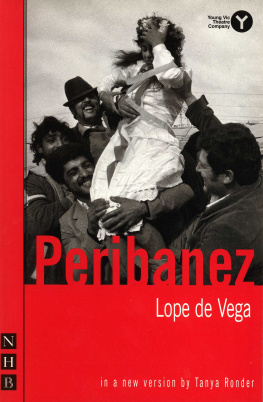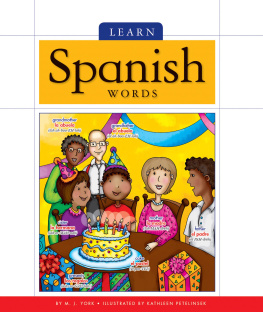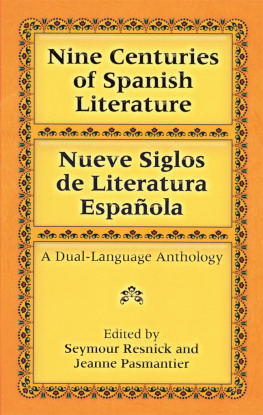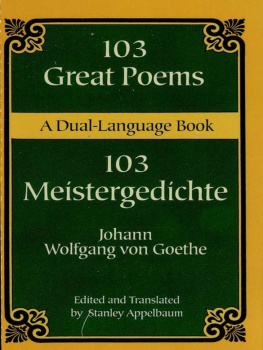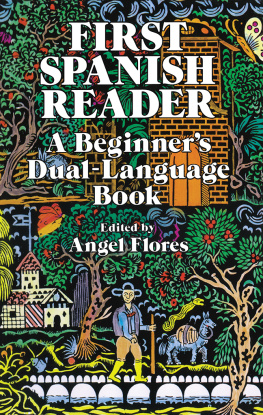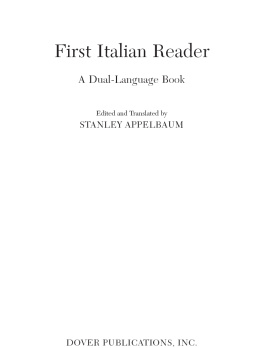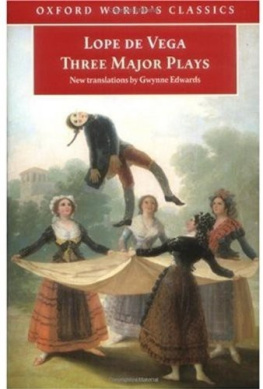A Second Spanish Reader
A Second Spanish Reader
A Dual-Language Book
Edited and Translated by
STANLEY APPELBAUM
DOVER PUBLICATIONS, INC.
Mineola, New York
Copyright
Selection, English translations, Preface, and Introduction copyright 2009 by Dover Publications, Inc.
All rights reserved.
Bibliographical Note
This Dover edition, first published in 2009, is a new selection of excerpts from 50 Spanish and Spanish-American authors (reprinted from standard texts) writing between ca. 1540 and ca. 1920 (the original publication dates extend from 1552 to 1922; see Introduction for data on individual authors), together with new English translations by Stanley Appelbaum, who made the selection and wrote the Preface and Introduction.
Library of Congress Cataloging-in-Publication Data
A second Spanish reader : a dual-language book / edited and translated by Stanley Appelbaum.
p. cm.
In English and Spanish.
Summary: A new selection of excerpts from 50 Spanish and Spanish-American authors (reprinted from standard texts) writing between ca. 1540 and ca. 1920.
ISBN-13: 978-0-486-47235-5
ISBN-10: 0-486-47235-3
1. Spanish languageReaders. I. Appelbaum, Stanley.
PC4117.S37 2009
468.6421dc22
2009010094
Manufactured in the United States by Courier Corporation
47235302
www.doverpublications.com
PREFACE
A Second Spanish Reader is a more advanced follow-up to Dovers First Spanish Reader (Angel Flores, ed.; 1988; ISBN 0-486-25810-6).
The present volume is comprised of excerpts (with new corresponding translations into English on facing pages) from actual works by fifty different authors, all of them important enough to have entries of their own in the Oxford Companion to Spanish Literature (except for Bolvar, the South American Liberator, who was not a professional writer). Each excerpt is roughly two pages long (per language). Of the fifty authors, seventeen are from Spanish America: four each from Argentina, Chile, and Mexico; two from Cuba; and one each from Venezuela, Nicaragua, and Uruguay. Included are four women and two Nobel laureates.
The Spanish texts, though relatively unchallenging, are left exactly as originally written, except that the spelling has been modernized or regularized wherever necessary. Most of the excerpts are continuous; only in a handful of cases are particularly difficult paragraphs or longer passages omitted, such omissions being indicated by an ellipsis in square brackets: [...]. (Such adjuncts as section numbers and headings, epigraphs, footnotes, and stage directions are intentionally left out.) In general, the texts do not involve slang, jargon, archaic vocabulary, technical terms, dialects or languages other than Castilian, or material demanding lengthy explanations; the brief annotations thought desirable have been included in the Introduction, which concisely discusses all fifty authors and works. (This annotation was limited by considerations of space; a basic knowledge of the history and geography involved will come in handy.) Many of the excerpts occur at or near the very beginning of the works from which they are taken; this has two advantages: it avoids explaining plot complications, and openings are often written with particular care. There is no duplication of material already in earlier Dover dual-language books.
To avoid difficulties stemming from older forms of Spanish, the excerpts begin around 1550, the outset of the hundred or so years known as the Golden Age; various major genres and authors of this period are included, such as the three chief playwrights, the pastoral and picaresque novels, the religious meditation, and the report from the New World. Three outstanding exponents of the 18th-century Enlightenment will also be found here. The 19th and early 20th centuries are especially well represented: the major Romantic playwrights and poets; masters of costumbrismo (see no. 16 in the Introduction); several Realist and Naturalist novelists; the poets of modernismo (see no. 41); and the pillars of the Generation of 1898.
Here readers can make or renew their acquaintance with such authors as Lope de Vega, Cervantes, Alarcn, Unamuno, and Daro, and with such works as El buscn, Cartas marruecas, El estudiante de Salamanca, and Santa. They will find plays, lyric and narrative verse, and prose of many kinds: fiction, philosophy, autobiography, and more. There are serious and humorous worksa generous sampling of an extraordinarily diverse and rich literary heritage.
INTRODUCTION
Known as the Apostle of the Indies (the New World), B ARTOLOM DE LAS C ASAS (1474?1566) was born in Seville, but had become a rancher on Hispaniola (later, Haiti and the Dominican Republic) by 1512. Ten years later he turned to religion, becoming a Dominican friar in 1523, and was finally named bishop of Chiapas in Guatemala. His major work was the Historia de las Indias (begun 1527, left incomplete in 1561), but he is more widely known for his Brevsima relacin de la destruccin de las Indias (Very Brief Report on the Destruction of the Indies; written 1542, published 1552), in which he informs the king of Spain of the genocide carried out by the conquistadores among the aborigines (the work is also one of the earliest appearances of the noble savage theme). The friars findings were rejected, and to this day he is often accused of serious exaggeration. Our selection is the entire chapter on Cuba.
The greatest pastoral novel in Castilian (emulated by Lope, Cervantes, Sidney, and others) is Los siete libros de la Diana (The Seven Books of Diana; first published 1559?) by the courtier J ORGE DE M ONTEMAYOR (1519?1561), who was born near Coimbra in Portugal and moved to Spain around 1543; a sometime chapel chorister and diplomat, he was murdered in Piedmont. Montemayor, who also wrote lyric verse, religious pieces, and translations, based his Diana on classical and Italian Renaissance models. The elegantly though artificially composed book examines the theme of all-conquering love from many angles; Diana, sincerely loved by one shepherd, weds another and becomes unhappy. Our excerpt is the very beginning of Book III, the preamble to one of the major interpolated love stories.
Fray (Friar) L UIS DE L EN (1527?1591), born in Cuenca province, Castile, is one of the greatest 16th-century Spanish poets and prose writers. After law studies in Salamanca, he entered the Augustinian order in 1544 and obtained the chair of theology at his alma mater in 1561; from 1572 to 1576 he was confined by the Inquisition for such crimes as criticizing the approved Latin translation of the Bible, but he was later reinstated in his professorship and was named to a high religious post in the year of his death. In De los nombres de Cristo, a dialogue written at least partly while he was jailed, and published in 1583, he meditates on the terms alluding to Christ in the Scriptures, such as The Way, The Shepherd, and The Bridegroom, considering this analysis as a means to understanding His essence even in this life. The author presents his theology in the vernacular, like his great contemporaries Saint Teresa of vila and Saint John of the Cross. Our excerpt is the very opening of his explanatory preface, addressed to a royal counselor and member of the Inquisition.
One of the great Spanish genres in the 17th-century Golden Age (inspired by earlier initiatives) was the picaresque novel, generally a rambling, witty, first-person account of the misdeeds of confidence men and other rogues. Of the three major examples in this Reader, the novel Guzmn de Alfarache (published in two volumes, 1599 and 1604), the true prototype of the developed genre, was written by M ATEO A LEMN (15471615). Born in Seville, he converted from Judaism, studied medicine, was jailed three times, visited Mexico, and ended as a prelate and religious writer. In the novel, Guzmn is a gambler and a thief who makes cynical use of religion but is converted while being punished as a galley slave. Our excerpt is the beginning of chapter VIII , an interpolated tale of Moorish lovers, narrated to Guzmn by a priest encountered on the road. Baza, in Granada province, was reconquered by Ferdinand and Isabella in 1489.
Next page
